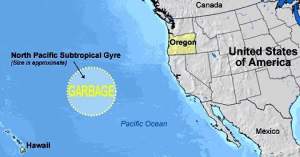Since birth I have always been surrounded by salt water. Having lived in Alaska my whole life, the ocean consumed much of our daily activities. My dad fished for the first 5 years of my life so summers consisted of living on the boat. A required class in middle school was cold water survival, what to do if you were ever stranded in the water or on the beach. In this class we learned that how you reacted in the first two minutes of being in cold water were the most important for survival.
With the ocean being such an important part of my life I have come to a certain respect for the ocean and the creatures that swim beneath. Having a respect for the ocean leads me to be disturbed when careless individuals or organizations dispose of waste into these waters. Being from an island I feel that I have been more cautious of my disposal because unlike towns who send their garbage to a giant trash mound in the middle of the state it is almost impossible to do that on our island which consists of 46 square miles.
This Christmas break my family and I travelled to Hawaii, which was the best vacation ever. Here there were a lot of parallels to my home, other than the huge climate gap, when it came to being environmentally cautious. I was greatly surprised when I found out that the state had banned the use of plastic bags in all stores. It is these kinds of actions that help me believe that people are aware that a change needs to take place. It was on the Big Island that I watched an activity which made me retract on my praise towards this states stride towards being green.
One morning we ventured down to south point, which is the southernmost tip of the USA. We were in awe with the great panoramic views where you could see no other land, only ocean. As I looked out off the cliffs I noticed a plastic garbage bag that floated a couple hundred feet from the cliff face. That puzzled me and as I noticed one I would then notice another, and another. It took us a while to figure out that these bags were attached to fishing lines of the local people fishing. Shoreline fishermen use garbage bags to haul their lines to deep water off of South Point. The strong winds push the bag with the fishing lines attached out far and they are able to catch open water fish. While they have a good reason for doing this they are still adding to ocean pollution because many bags get away and drift off to sea.
Where do these gar bage bags go? One very likely place is the Great Pacific Garbage Patch also known as the Pacific Trash Vortex. This garbage vortex is located in the waters halfway between Hawaii and the coast of California. The size is estimated to be the size of Texas and consists of mostly plastic products.
bage bags go? One very likely place is the Great Pacific Garbage Patch also known as the Pacific Trash Vortex. This garbage vortex is located in the waters halfway between Hawaii and the coast of California. The size is estimated to be the size of Texas and consists of mostly plastic products.
Once back in Spokane my dad sent me an article that related amazingly to what we saw in Hawaii. In the beginning of January, 10 miles north of Ketchikan Alaska a man found a 171 lbs., 3 foot long green sea turtle. This turtle that apparently had got into the wrong current was washed on shore and when they conducted a necropsy found the cause of death to be bronchial obstruction and lung collapse due to cold. What the interesting part is that they also found two types of plastic bags and a wad of monofilament fishing line in the stomach. Somewhere along this turtles journey it had swallowed these plastic bags possibly mistaking them for food. This is a reoccurring problem with our sea creatures one that will only stop if people understand how important it is to keep our oceans clean.
Tips for keeping our oceans clean:
– Recycled old fishing line: Monofilament fishing line takes up to 600 years to break down in the marine environment and can entangle and kill wildlife. Look for recycling facilities in your marina.
– Join beach cleanups: One helpful activity would be to join a beach cleanup or pick up trash whenever you can and dispose of it properly.










